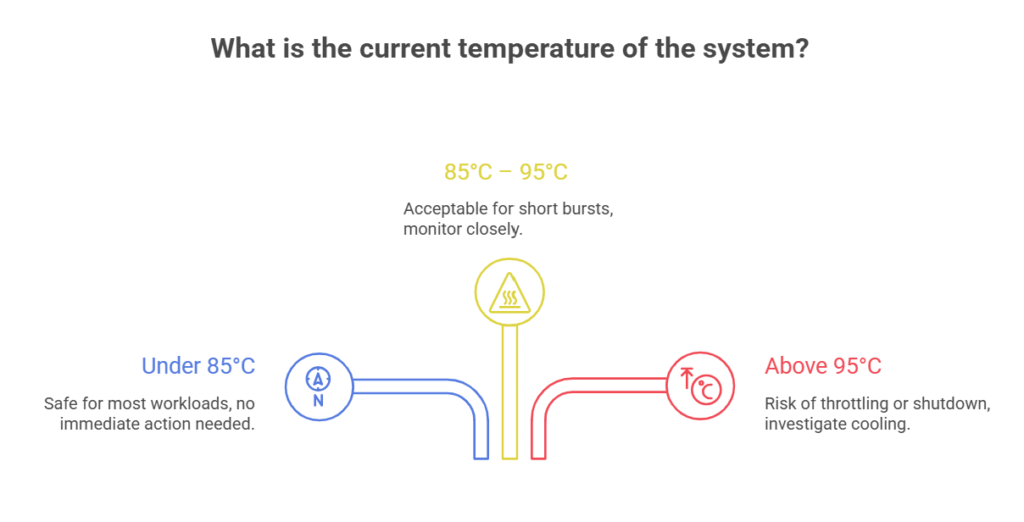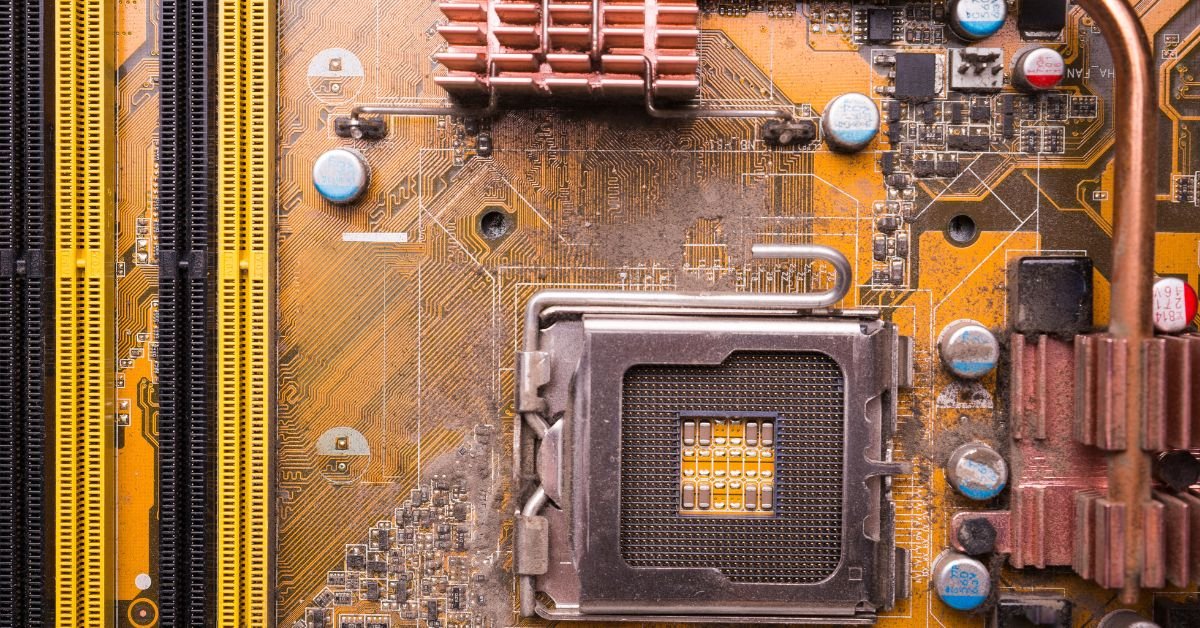CPUs are the brains of your computer, and like any hard-working brain, they generate heat. But why does it seem like CPUs are running hotter than ever? The answer lies in a mix of more powerful chips, smaller manufacturing processes, and the ever-increasing demands of modern software.
The Evolution of CPUs: More Power, More Heat
In 2025, CPUs are packing more cores and higher clock speeds than ever before. While this means better performance, it also means more heat. Add in AI workloads, 4K gaming, and heavy multitasking, and it’s no wonder your CPU temp can spike.
Real-Life Example
A user recently shared, “I upgraded to the latest Ryzen 9000 series, and suddenly my idle temps are 50°C, with gaming temps hitting 90°C. Is this normal, or am I frying my chip?”
This is a common concern, and it’s not just about the numbers—it’s about understanding what’s safe and what’s not.
What’s a Normal CPU Temperature in 2025?
Let’s answer the big question: What temp should my CPU be? The answer depends on your CPU model, workload, and cooling solution.
Temperature Normal CPU: The 2025 Baseline
- Idle (desktop, light browsing): 35°C – 50°C
- Gaming or heavy use: 65°C – 85°C
- Max safe temp (short bursts): 90°C – 100°C (varies by model)
Most modern CPUs are designed to handle brief spikes up to 100°C, but sustained high temps can shorten lifespan or cause throttling.
Quick Reference Table
| State | Normal Temp Range |
|---|---|
| Idle | 35°C – 50°C |
| Gaming/Load | 65°C – 85°C |
| Max Safe Burst | 90°C – 100°C |
What Happens If My CPU Overheats?
When your CPU temp is high, your PC will try to protect itself. Here’s what can happen:
- Thermal Throttling: The CPU slows down to reduce heat, causing lag or stutter.
- System Shutdown: If temps get too high, your PC may shut down to prevent damage.
- Component Wear: Prolonged high temps can degrade your CPU and motherboard over time.
Is It Dangerous?
A brief spike isn’t the end of the world. But if your CPU is constantly running hot, it’s time to investigate. The good news? Most CPUs have built-in protections, but it’s still best to keep temps in check.
What Causes a PC Super Hot CPU Temp High?
Let’s break down the most common culprits:
Poor Cooling or Dust Buildup
Fans clogged with dust, old thermal paste, or a failing cooler can all lead to high temps. Even the best CPU can’t stay cool if airflow is blocked.
Overclocking
Pushing your CPU beyond its rated speeds can deliver more performance—but also more heat. If you’re overclocking, make sure your cooling is up to the task.
High Ambient Temperatures
Is your room hot? Your PC will be, too. Summer heatwaves or a cramped desk can raise your baseline temps.
Background Processes
Sometimes, a rogue app or background process can max out your CPU without you realizing it. Always check your Task Manager for unexpected activity.
Poor Case Airflow
A case with bad airflow traps heat inside. Make sure your fans are set up for optimal intake and exhaust.
How to Check Your CPU Temperature
Before you panic, let’s check your actual temps. Here’s how:
Using Built-In Tools
- Windows 11/12: Open Task Manager > Performance > CPU. Some systems show temps here.
- BIOS/UEFI: Restart and enter BIOS to see real-time temps.
Third-Party Apps
- HWMonitor
- Core Temp
- HWiNFO
These tools give you detailed readings for each CPU core.
What Temp Should My CPU Be? Safe CPU Temp Guidelines
So, what’s a safe CPU temp in 2025? Here’s a quick guide:
- Under 85°C: Generally safe for most workloads.
- 85°C – 95°C: Acceptable for short bursts, but not ideal for long sessions.
- Above 95°C: Risk of throttling or shutdown. Investigate cooling.

Pro Tip
If your CPU is idling above 60°C or hitting 100°C under load, it’s time to act.
How to Lower High CPU Temps: Step-by-Step
If you’re seeing a PC super hot CPU temp high, don’t worry. Here’s how to cool things down:
Clean Your PC
Dust is the enemy of cooling. Power down, open your case, and gently clean fans and heatsinks with compressed air.
Reapply Thermal Paste
Old or poorly applied thermal paste can cause high temps. Replace it every 2–3 years for best results.
Upgrade Your Cooler
Stock coolers are fine for basic use, but gaming or heavy workloads need better cooling. Consider a quality air cooler or an AIO liquid cooler.
Improve Case Airflow
Add intake and exhaust fans. Make sure cables aren’t blocking airflow.
Check Fan Curves
Use your motherboard’s software to set more aggressive fan curves. More airflow = lower temps.
Lower Overclocks
If you’re overclocking, dial it back a bit. Stability is more important than a few extra MHz.
Monitor Background Apps
Close unnecessary apps and check for malware. Sometimes, a hidden process is the real culprit.
Real-World User Experience
Here’s a quote from a PC enthusiast:
“After months of random shutdowns, I finally checked my CPU temps—turns out my cooler was loose! Tightened it, reapplied paste, and now my temps dropped by 20°C. Lesson learned: always check the basics first.”
Advanced Tips for Keeping Your CPU Cool in 2025
Undervolting
Modern CPUs often run at higher voltages than necessary. Undervolting can reduce temps without sacrificing performance. Use tools like Intel XTU or AMD Ryzen Master.
Custom Water Cooling
For enthusiasts, custom loops offer the best cooling—but require more maintenance and cost.
Upgrade Your Case
Some cases are designed for airflow, with mesh panels and optimized layouts. If your case is old or cramped, an upgrade can make a big difference.
Monitor Ambient Temps
If your room is hot, consider moving your PC or using air conditioning. Even a small drop in room temp can help.
Pros and Cons of High CPU Temps
Let’s be real: sometimes, high temps are unavoidable. But what are the risks and benefits?
Pros
- Higher Performance: Some CPUs boost higher when temps are under control.
- Short Bursts Are OK: Modern CPUs can handle brief spikes.
Cons
- Reduced Lifespan: Prolonged high temps can degrade components.
- Throttling: Performance drops when temps get too high.
- System Instability: Crashes, freezes, or shutdowns.
Features to Look for in 2025 Cooling Solutions
If you’re shopping for a new cooler, here’s what matters:
- TDP Rating: Make sure your cooler matches your CPU’s power draw.
- Fan Quality: Look for high static pressure and low noise.
- Ease of Installation: Some coolers are easier to mount than others.
- RGB (Optional): For those who want style with their substance.
Usability: Keeping Your PC Cool Without the Hassle
You don’t need to be a tech wizard to keep your CPU cool. Most fixes are simple:
- Clean your PC regularly.
- Monitor temps with free software.
- Upgrade cooling if you’re gaming or editing video.
A little maintenance goes a long way.
FAQs
Q. What is a safe CPU temp while gaming in 2025?
A. safe CPU temp while gaming is typically under 85°C. Some high-end CPUs can handle up to 95°C for short periods, but it’s best to stay below 85°C for long sessions
Q. Why is my CPU temp so high even at idle?
A. High idle temps can be caused by dust buildup, poor thermal paste, background processes, or a failing cooler. Check your Task Manager and clean your PC.
Q. Can high CPU temps damage my computer?
A. Yes, sustained high temps can reduce your CPU’s lifespan and cause system instability. Modern CPUs have protections, but it’s best to keep temps in check.
Q. How often should I replace thermal paste?
A. For most users, every 2–3 years is sufficient. If you notice temps rising or change your cooler, reapply thermal paste.
Final Thoughts
A PC super hot CPU temp high isn’t just a number—it’s a warning sign. But with a little know-how and regular maintenance, you can keep your system running cool and smooth for years to come.
CLICK HERE FOR MORE BLOG POSTS
John Authers is a seasoned and respected writer whose work reflects the tone, clarity, and emotional intelligence that readers value in 2025. His writing blends deep insight with a natural, human voice—making complex ideas feel relatable and engaging. Every piece he crafts feels thoughtful, original, and genuinely worth reading.

